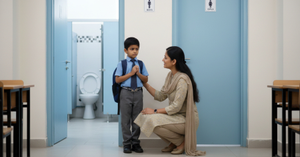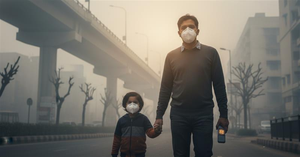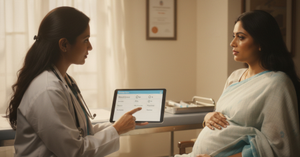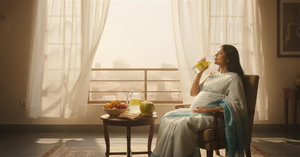Seasonal changes present unique challenges to ocular health, affecting both children and adults. Temperature fluctuations, humidity variations, and seasonal allergens can contribute to eye irritation, infections, and chronic conditions such as allergic conjunctivitis or dry eye syndrome. Studies in Ophthalmology and Indian Journal of Ophthalmology have underscored the importance of season-specific preventive strategies to minimize ocular morbidity across all age groups.
Spring: Managing Allergens and Itchy Eyes
Spring brings high pollen counts, a common trigger for allergic conjunctivitis in children and adults. Symptoms often include redness, itching, tearing, and eyelid swelling. Evidence from Allergy & Asthma Proceedings indicates that children are especially vulnerable due to outdoor activities during pollen peaks.
Dr. Santosh Honavar, senior pediatric ophthalmologist, advises, “During spring, keeping windows closed during high pollen times, encouraging children to wash hands and faces after outdoor play, and using prescribed antihistamine eye drops can significantly reduce allergic eye symptoms.”
Cold compresses applied over closed eyelids can relieve itching, and daily bathing helps remove pollen residues from the hair and skin.
Summer: Guarding Against UV Damage
Summer months increase exposure to ultraviolet (UV) radiation, which has been implicated in pterygium, pinguecula, and long-term risks such as cataracts and retinal damage. Sunglasses labeled with 100% UVA/UVB protection should be worn by all family members when outdoors, including children, as pediatric lenses allow more UV penetration than adult lenses.
Wide-brimmed hats provide additional protection by blocking direct sunlight. Swimming goggles should be used in pools to prevent irritation from chlorinated water, a cause of chemical conjunctivitis.
Monsoon: Preventing Infections
High humidity and water stagnation during monsoons promote the spread of infectious agents. Bacterial and viral conjunctivitis cases spike during this period, especially among school-aged children. Parents should teach children not to touch or rub their eyes and to avoid sharing towels or handkerchiefs.
Dr. Rohit Saxena, AIIMS ophthalmologist, notes, “We see a sharp rise in infectious conjunctivitis during monsoon. Early consultation and adherence to hygiene practices, like frequent handwashing and using individual face cloths, help control the spread.”
If eye redness with discharge develops, prompt evaluation is essential; antibiotic or antiviral drops may be needed depending on the cause.
Autumn: Adjusting to Dry, Dusty Air
Autumn in many regions is marked by drier air and increased dust, which can irritate the ocular surface. Parents report increased complaints of grittiness and discomfort in both children and adults during these months. Artificial tears can help maintain moisture in the eyes, while protective eyewear or wraparound glasses shield against dust during outdoor activities.
Keeping indoor spaces clean and well-ventilated reduces particulate exposure, as supported by studies in Cornea journal, which have identified environmental dust as a contributor to ocular surface inflammation.
Winter: Combating Dryness and Irritation
Cold air combined with indoor heating during winter lowers humidity, leading to evaporative dry eye symptoms such as burning, redness, and foreign body sensation. The Tear Film & Ocular Surface Society recommends using humidifiers to maintain indoor humidity at 40–60% and taking frequent breaks from heating vents or blowers directed at the face.
Staying hydrated by drinking adequate water also supports tear production. Warm compresses applied to closed eyelids can improve meibomian gland function, enhancing lipid layer stability in tears and reducing evaporation.
Parental Insights on Seasonal Eye Care
Parents implementing seasonal strategies report fewer eye-related complaints and better adherence to outdoor activities. Mrs. Aparna Sharma, mother of two schoolchildren, shared, “Using sunglasses and hats during summer and installing a humidifier in winter reduced my kids’ eye irritation significantly. We haven’t had any episodes of conjunctivitis since following these precautions.”
Conclusion
Seasonal eye care is a practical, effective approach to safeguarding the ocular health of all family members. Preventive measures such as UV protection in summer, allergen avoidance in spring, infection control during monsoon, and humidity management in autumn and winter reduce the incidence of acute and chronic ocular conditions. Awareness and proactive strategies, supported by ophthalmologist guidance and parental commitment, ensure optimal eye comfort and health year-round.
References
- American Academy of Ophthalmology. UV Safety for Eyes: Protecting Vision Year-Round. San Francisco, CA: AAO; 2023.
- Bielory L, et al. Seasonal allergic conjunctivitis: Management and therapeutic options. Allergy Asthma Proc. 2021;42(2):104-112.
- Indian Journal of Ophthalmology. Seasonal variation of conjunctivitis cases in children: Epidemiological findings. Indian J Ophthalmol. 2022;70(4):1231-1236.
- Sheppard JD, et al. The epidemiology and etiology of dry eye disease. Cornea. 2019;38(Suppl 1):S1-S19.









Be the first one to comment on this story.